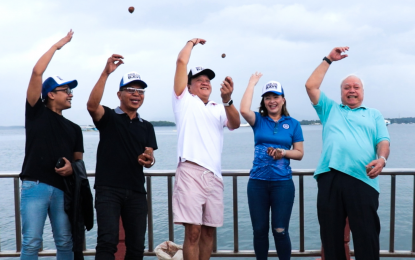
MUDBALLS PITCH. Puerto Princesa Mayor Lucilo Bayron (right) leads the ceremonial tossing of mudballs into the city bay to launch the "Save the Puerto Princesa Bays" project on Saturday (July 15, 2023). The mudballs contain microorganisms that will hasten the recovery of the marine ecosystem. (Photo from Puerto Princesa-CIO)
PUERTO PRINCESA CITY, Palawan – The city administration on Saturday kicked off a massive environmental recovery program aimed at preserving the aquatic ecosystem along this city’s 416-kilometer-long coastline that is threatened by a growing population.
Ceremonies marking the start of the "Save the Puerto Princesa Bays" program were held in Mandaragat, a coastal village that is currently hosting a large number of informal settlers.
During the event, Mayor Lucilo Bayron said the 5,500 coastal households are mostly responsible for the destruction of the ecosystem, and the time has come to relocate them.
He said the situation is further worsened by untreated wastewater pouring from 17 outfalls that dump directly into the sea.
An estimated 25,000 Puerto Princesa Bay residents release all sorts of household and livestock waste directly into the coastal waters, according to the mayor.
It was explained that human and animal refuse contain toxic substances that contaminate water.
The pollution depletes oxygen levels and upsets the delicate ecological equilibrium necessary for the bay's marine life to thrive.
During his address to the residents and barangay officials of Mandaragat, Bayron highlighted the importance of coastal residents refraining from polluting the city bay, which is the primary objective of the save the bays initiative, while they await relocation.
"What I see as a way to save the city bay -- the long-term solution, is to relocate the coastal dwellers. Why? Because they are living in a danger zone. It's not just a danger zone, it is an area that cannot truly belong to them because it is a salvage zone," he added.
He informed the audience that the city government has already acquired two land properties in the villages of Irawan and San Jose for their eventual move.
The sizeable land plots will see the construction of affordable and comfortable housing units with the assistance of the Pambansang Pabahay Program under the Department of Human Settlements and Urban Development.
"We will ride on the national housing program of President Marcos, which will provide 1 million housing every year for the next six years," he said.
Barangay Irawan, covering an expansive area of 21 hectares, will be the site for apartment-type buildings that will house some 7,680 families currently living in informal settlements along the city’s coast.
Additionally, a two-hectare property in Barangay San Jose, which will be developed simultaneously, is expected to house 2,496 families.
After the coastal area is vacated, it will be reclaimed to prevent informal settlers from squatting again, said Bayron.
"We need two solutions -- improving our settlement in the coastal area and properly managing the flow of wastewater towards our ocean," he said, acknowledging that this will be a lengthy process that cannot be accomplished within a timeframe of two to three years.
He stated that while Puerto Princesa Bay will be the initial focus of the coastal rejuvenation initiative, it will later expand to include Honda and Ulugan bays, as well as the smaller Oyster, Binunsalian, and Turtle bays.
Along with Vice Mayor Maria Nancy Socrates, Barangay Mandaragat captain Gerard Abad, members of the City Council, uniformed personnel, and other volunteers, Bayron led the ceremonial dispersal of mudballs at the inauguration of the bay conservation efforts.
Beneficial bacteria were included in the effective microorganisms (EM) contained in the mudballs. These microorganisms regulate the concentrations of ammonia and waterborne pollutants in the environment.
He said that by introducing EM-infused mudballs into the water, the microorganisms are released, assisting in the decomposition of pollutants and promoting a healthier ecological balance, according to him.
It will help improve water quality, mitigating the negative effects of ammonia and other pollutants on the aquatic ecosystem, he emphasized. (PNA)
